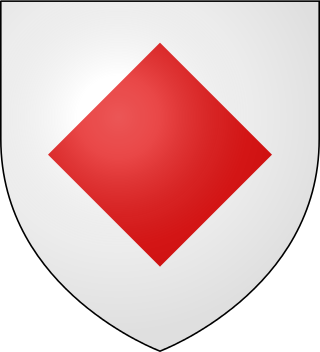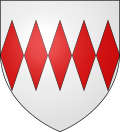Lozenge (heraldry)
Heraldic charge From Wikipedia, the free encyclopedia
The lozenge in heraldry is a diamond-shaped rhombus charge (an object that can be placed on the field of the shield), usually somewhat narrower than it is tall. It is to be distinguished in modern heraldry from the fusil, which is like the lozenge but narrower, though the distinction has not always been as fine and is not always observed even today. A mascle is a voided lozenge—that is, a lozenge with a lozenge-shaped hole in the middle—and the rarer rustre is a lozenge containing a circular hole in the centre. A lozenge throughout has "four corners touching the border of the escutcheon".[1] A field covered in a pattern of lozenges is described as lozengy; similar fields of mascles are masculy, and fusils, fusily (see Variation of the field). In civic heraldry, a lozenge sable is often used in coal-mining communities to represent a lump of coal.

This article includes a list of general references, but it lacks sufficient corresponding inline citations. (September 2014) |

A lozenge-shaped escutcheon is used to depict heraldry for a female (in continental Europe especially an unmarried woman), but is also sometimes used as a shape for mural monuments in churches which commemorate females, as a shield was considered inappropriate for women who did not generally participate in combat; for the same reason, clergymen were also sometimes given oval-shaped arms.[2][3] Funerary hatchments are generally shown within lozenge-shaped frames, for both male and female deceased.
Types
- Lozenge: a diamond-shaped rhombus, usually somewhat narrower than it is tall
- Lozenge throughout[4] or grand Lozenge:[4] a lozenge "with four corners touching the borders of the escutcheon".[5]
- Fusil: a thin lozenge; very much taller than it is wide.
- Mascle: a voided lozenge (i.e. with a largish lozenge-shaped hole)
- Rustre (very rare): a lozenge pierced (i.e. with a smallish round hole)
- 3 lozenges—Gules, three lozenges argent— Guillaume de Haer (according to Gelre)
- 9 mascles—Gules, nine mascles or—Rohan family of France
- "Or, a lozenge sable"
- Fusils
- Mascles
- A rustre
Lozengy
The blason Lozengy is a form of variation of the field or of another charge (for example a chevron lozengy) which consists of lozenges semée, or sown like seeds (Latin: semen, a seed), or strewn across the field, but in an organised contiguous pattern. The arms granted to the Canadian John Francis Cappucci bring an example of lozengy voided, the same as "lozengy" but with a smaller lozenge-shaped hole cut out of each segment.[6]
Examples
- Lozengy or and azure (effectively a field azure semée with lozenges or)
- Lozengy azure and or (effectively a field or semée with lozenges azure)
- A lozengy shield
- This Monegasque flag is "lozengy gules and argent"
- A variant Flag of Bavaria, an array of 21 or more lozenges bendwise of white and blue (blazoned as a field "fusilly in bend" or sometimes "bendy lozengy").
- The personal arms of Margaret of Parma
- The arms of Isabella Clara Eugenia of Spain
- The personal coat of arms of Anne, Princess Royal displayed on a lozenge.
- Arms of Borredà, a municipality in Catalonia
Lozenges on flags
Lozenge
- Flag of Shiwa, Iwate, Japan
Lozenge throughout
Mascle
- Flag of the Red Crystal (Third Protocol of the Geneva Conventions)
Rustré
- Flag of Behlendorf, Schleswig-Holstein, Germany
- Flag of Duvensee, Schleswig-Holstein, Germany
Lozengy
Nowy lozengy
- Flag of New Milford, Connecticut, USA
- Flag of the Forest Finns
See also
- Weckeler, an historical coin named after its depiction of a heraldic lozenge or lozenged shield
- c:Gallery of flags by design II: Mobile charges
References
Further reading
Wikiwand - on
Seamless Wikipedia browsing. On steroids.





































